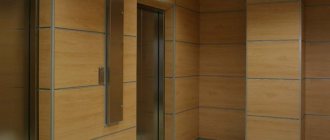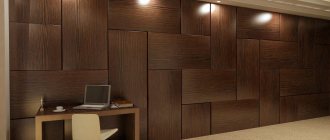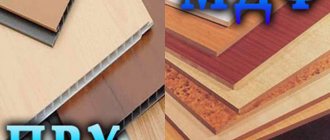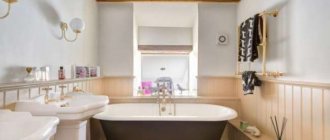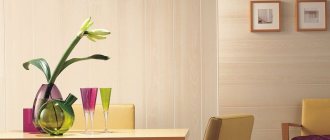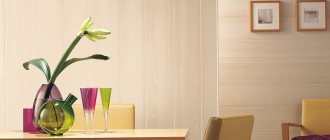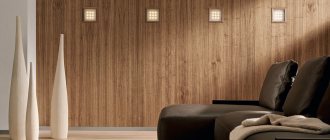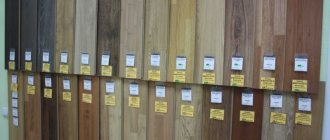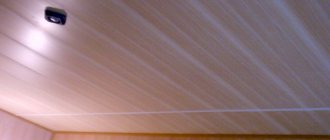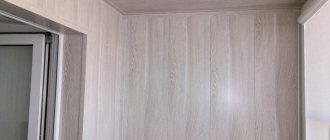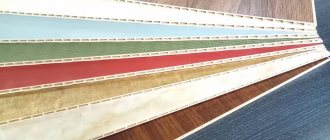What are MDF panels
Panels made from finely dispersed fraction (MDF) of wood are a finishing material made from medium-density fiberboards. They are made by dry pressing small wood fragments - chips, shavings and sawdust under high pressure at high temperature. The binding elements are synthetic resins (urea-formaldehyde) and melamine modifier, which is no more toxic than table salt. Together, these components provide very low emissions (release of formaldehyde into the environment), comparable to the emissions of natural wood (class E1). For comparison, chipboard emissions can be of class E2, E3, E4.
Production process Source finitura.ru
The production process is as follows:
- first, in a defibrator, over several cycles, the wood is separated into fibers at a humidity of 80% and a temperature of 100 degrees;
- in the last cycle, binder resins and modifiers are introduced;
- then the mass is dried for several seconds with an air stream at a temperature of 240 degrees;
- the dry mass is formed by the carpet;
- pressed;
- Cool for 20 minutes;
- polished.
In the production of MDF panels Source vlasenko.at.ua
The Americans were the first to create MDF in 1966. The launch of industrial production in Russia began in 1997. The world leader in this segment is China.
During the production process of slabs, it is possible to give them special properties:
- water resistance;
- biostability;
- fire resistance.
The density of the material can be 600-800 kg/m³, thickness - 2-40 mm. The panels are available in various widths and lengths. On the construction market they are presented in a different color palette and come with a textured pattern (wood, stone). It is better to decorate walls and ceilings made of MDF panels with materials that imitate valuable wood (economy panels). Since the structure of the material is homogeneous, its finish absorbs sound well and is easy to cut during installation, forming dust, but not shavings (unlike chipboard). Installation of MDF panels can be vertical or horizontal, on a frame, adhesive or self-tapping screws.
TOP 8 types of MDF wall panels
According to their shape, the panels are:
1 In the form of slats (narrow panels) having a groove connection: groove - ridge. They are easy to install independently and are widely used for cladding.
Narrow panels with a groove connection
2 In the form of sheets of various sizes. The sufficient area of the sheet allows you to use different techniques for its design: photo printing. 3D images, panels and graphics.
Sheets of panels of various sizes
3 In the form of slabs, similar to large tiles. To fasten the design of these products, just like slatted panels, a “groove-tongue” locking connection is provided.
Slabs similar to ceramic tiles
Based on their appearance they are produced:
4 With a veneered surface , when the top layer consists of a thin coating of natural wood, which is called veneer. The product looks completely identical to a natural wooden board and is significantly less expensive.
Panels with veneer surface
5 With a laminated surface , which is a thin coating of a special film, imitating various natural materials, colored or plain patterns. The wide variety of designs makes laminated products the most popular MDF products for wall cladding.
The most popular laminated panels
6 With a painted surface , when the lamella is painted on top in a variety of color shades. Paint performs a protective and decorative function.
Painted wall panels
7 Panels with photo printing. The image is applied to the front side of the panel. The top is coated with acrylic colorless varnish, which protects it from external damage.
Panels with photo printing
8 Panels with a pattern or design that has a 3D effect. These products have been recently developed and are a new design. The surface of the products, which depicts abstract three-dimensional drawings, geometric figures imitating various types of relief, looks unusual and very impressive.
3D effect on panels with a pattern
Types and sizes of MDF panels
There are several varieties, depending on the design of the front side:
- Painted. The planks are coated with paint of any color, most often not simulating wood.
Variety of color palette Source plintus-store.ru
- Laminated. Thanks to the wide variety of PVC films for lamination, the surface can be glossy, matte, with a print that does not necessarily imitate wood. Due to this variety, laminated panel is in high demand. In addition, lamination imparts additional strength and wear resistance, which increases service life.
- Veneered. The panels covered with a thin layer of natural veneer certainly look noble and respectable. After gluing to MDF panels, sections of wood are sanded, primed and varnished, which protects the wood from moisture and mechanical damage.
- Cork . Here a thin layer of cork is used for coating. Such panels are expensive and, as a rule, do not live up to design expectations.
- Decorative . The coating imitates the color and texture of stone, brick, tile, and leather.
A wide variety of materials allows you to choose the necessary modification, depending on the style of the interior.
Panels with 3D effect Source www.dizainvfoto.ru
Products produced by different manufacturers vary in size. Most often the length of the sheet is 260 cm, but it also happens 240, 250, 270 cm. The width is usually 15-90 cm, less often - 120 cm.
See also: Catalog of house projects with facade finishing with fiber cement and clinker thermal panels.
Types of panels
Not all MDF is created equal and can be purchased for all types of jobs. It is important to understand here that there are certain types of panels, and each is used only in certain cases.
MDF panels are not only a budget solution for wall decoration, but also the lightest
Table. Main types of MDF.
| View | Characteristic |
| Whole pressed | This is a standard panel, which is produced precisely during the process of conventional pressing and is a sheet of wood fibers. The material will have moderate strength, a smooth surface, and good thermal and sound insulation. This MDF is inexpensive, but environmentally friendly and safe. Compared to analogues, this is the cheapest option. But the material is not highly moisture resistant, does not have any additional processing, and the color of different slabs may differ even in the same batch. Typically, such slabs are used for finishing premises for various purposes. |
| Moisture resistant | This panel has increased resistance to moisture, it is denser than the previous version, stronger and resistant to mechanical stress. Such panels can be used to decorate bathrooms. |
| Laminated | This is quite an expensive panel, but resistant to a number of influences. It is not afraid of water, since its surface is laminated and will not let moisture in. The panels are not afraid of abrasion, as well as exposure to a number of substances. Sometimes such panels, due to their stability, can even be used for outdoor work (the main thing is that they are not constantly exposed to water, so such panels should only be installed outdoors under awnings). |
| Other special | In theory, a moisture-resistant panel also belongs to this category, but it is used quite often and therefore was described separately. And so there are also heat-resistant, flexible panels and materials with increased density. Flexible ones can be used for finishing arches and other curved structures; high-density panels can cope well with strong mechanical stress, but heat-resistant or fire-resistant ones are not afraid of fire and practically do not burn due to the content of a number of special substances in them. And they can be fixed in the area of fireplaces and stoves, as well as very close to heating boilers. |
Photo of MDF panels for walls in the interior
Depending on how the MDF panel is finished, it is also divided into several types.
MDF wall panels
- Veneered , which resembles ordinary natural wood in appearance. Sometimes such a panel can hardly be distinguished from an ordinary wooden board. That is, the outside of the panel is covered with veneer - thanks to it, it is possible to achieve the desired appearance. Veneer is the thinnest layer of natural wood. This is the most expensive MDF option.
- The painted panel can have any color, which can be achieved by applying coloring compounds to the material. Moreover, MDF can be either matte or glossy. There is no imitation wood texture.
- Laminated panel is cheap and affordable, which explains its popularity. The outside is usually covered with melamine film. Such panels look beautiful, and they are not afraid of water. They are also quite easy to wash.
Laminated MDF panels with glossy surface
As for the format, the following can be used for wall decoration:
- slatted MDF, 2.5-3.8 mm long and 13-28 cm wide;
- square tile with a side width of 30-98 cm;
- sheet, with a length of one panel of 1.25-2.5 m.
In the apartment you can use both slatted and tile variations of MDF. But for finishing spacious rooms it is better to buy a sheet version.
If you decide to buy MDF panels, then do not forget to purchase materials for the frame
Prices for MDF panels
MDF panels
Advantages, disadvantages, installation methods
For any interior solution, it is important to choose the right finishing material and become familiar with its positive and negative qualities. MDF panels have many advantages:
- safe;
- relatively inexpensive;
- available in a wide range;
- installation of MDF panels is easy;
- They look beautiful and can add solidity to the room.
The only disadvantage can be considered susceptibility to moisture and fire, if during production they were not given moisture and fire resistance.
Installation of MDF panels on walls and ceilings can be done in several ways:
- The most common type of installation is clapboard, imitating board cladding. At the same time, the joints are well protected due to the tongue-and-groove connection. Simple technology allows you to carry out a large amount of work in a short time.
- A fairly common installation method is tiling. A fairly popular method, the tiles have clear dimensions, which allows you to accurately calculate the required amount of material.
- Sometimes MDF is used in the form of large sheets; they do not have a tongue-and-groove joint. The seams are decorated with special decorative elements. Sheets allow you to create a holistic design.
Moisture-resistant properties allow the material to be used in the kitchen. Source storge.pic2.me
In small rooms, it is recommended to use MDF panels for a wood-like ceiling if similar ones are not used on the walls, so that the room does not turn into a small box. If the walls are “wooden”, then it is better to choose MDF ceiling panels in light shades.
Methods for installing wall panels:
Installation methods and list of tools
- List of tools
Preparation for installation
- Calculation of material quantity
- Rules for using PVC sheets
Method of fastening to the lathing
- Marking
- Frame assembly
- Sheathing: instructions and video
Installation method with liquid nails and glue
- Glue selection
- Preparing the wall
- Panel installation
The article will contain two step-by-step instructions for installing wall panels with your own hands. We will tell you how to correctly install MDF, chipboard and PVC elements in different ways. These materials are most often used in finishing the kitchen area. They are lightweight, cheap compared to other designs, but at the same time quite durable, creating sound and heat insulation. Plastic and wood-fiber boards are moisture-resistant and easy to clean, which is especially important for the apron above the tabletop and the entire room as a whole.
Instagram @thatchedcottagecotswolds
Instagram @priya.aga
How to make a choice
First of all, you need to check the certificate of compliance of the material with quality standards. It must indicate that during production materials with formaldehyde emissions not exceeding class E1 and toxic resins were used. Then you should inspect the entire batch of the purchased goods - if there are a lot of defective elements (with unevenness, cracks, chips), it is better to refuse the purchase, regardless of the attractiveness of the price.
The choice of material should be approached responsibly Source drevplity.ru
See also: Catalog of companies that specialize in finishing materials, glazing and lighting of houses.
You should also pay attention to the manufacturer. Some of the best are the following:
- The Russian one has existed in the construction market for more than 20 years. LLC products have good quality indicators and are used in Russia and exported to Europe.
- Swiss krono group . A large European woodworking company with representative offices and factories in different countries.
- Sonae Industry . The Portuguese company is one of the largest in Europe; it has been producing MDF panels for over 30 years, constantly expanding its range.
- P&M Kaindl . A company from Austria occupies one of the leading positions in the production of MDF products. Advanced technologies and the latest equipment allow us to produce high-quality materials that are in demand all over the world.
Products of the Kaindl concern Source cdn.bitrix24.ru
The high quality of the products is indicated by a uniform color palette, uniform application of layers, without irregularities, layers, etc.
Advantages and disadvantages of MDF panels
MDF material, like chipboard, is created from ordinary wood chips using special technological devices necessary to ensure the hot pressing process.
MDF wall panels
Therefore, MDF does not contain any phenol substances, various resins, as well as all kinds of chemical compounds that can harm the human body. The advantages of MDF wall panels also include the following:
- Quite a high level of thermal insulation and soundproofing.
- The material can be decorated with a wide variety of colors and textures. The facing material can visually imitate wood, brick or stone.
- High level of environmental cleanliness.
- Quite a long service life.
- Easy to install with no preparatory procedures required.
- Manufacturers do not charge too high a price for such products.
However, certain disadvantages inherent to MDF cladding panels should be taken into account:
- Such panels cannot be called sufficiently moisture resistant, so they can become deformed over time.
- The fire resistance of the material also leaves much to be desired, so it is necessary to increase the level of fire safety in the room before installing such cladding.
- The impact resistance of MDF panels is also very low, so the possibility of deformation under mechanical stress cannot be ruled out.
Even with such serious shortcomings, many homeowners prefer MDF cladding panels.
Stages of installation of MDF panels
Before attaching MDF wall panels to the wall, you should decide on the installation method. If using “liquid nails” type glue, then the surface must be perfectly flat or leveled using plaster and putty or drywall.
In case of unevenness with a large difference, to hide communications or place insulation, MDF panels are fastened to the wall using a frame, with the help of which the entire future surface will be brought into one plane. It is mounted from a metal profile or a wooden block. The latter option is preferable, since fastening to it can be done with nails or staples from a construction stapler (depending on the thickness of the panels). For the metal profile you will need special screws and a screwdriver.
If you plan to build a frame, then before attaching the MDF panels, you need to inspect the walls, since ideal conditions for fungus are created in the space between them and the panels. Therefore, if the wall is noticeably moistened, the cause should be found and eliminated, dried and treated with appropriate compounds. Only after this can you begin building the frame.
Do-it-yourself MDF wall panels using glue and frame: installation options
Decorating walls with MDF panels has recently become increasingly popular, due to the fact that with their help you can quickly tidy up surfaces of a fairly large area. In addition, installation of the panels will not take much time, since you will not have to wait for numerous layers to dry, as, for example, in the case of plastering work. It also helps that the surface leveled by them does not require any additional finishing, as is the case with drywall. Another advantage of this material is its quite affordable price.
DIY MDF wall panels installation
Do-it-yourself MDF wall panels, which can be carried out even if there is absolutely no experience in this work, are installed quite simply. The main thing is to understand the principle of such cladding, prepare the surfaces and pay special attention to accurate calculations and markings.
What are MDF panels?
The abbreviation “MDF” stands for finely dispersed fraction, from which this finishing material is produced, including wall panels. The production of MDF involves the dry pressing of a fine mass of sawdust and wood shavings using high temperatures and pressure. To bind the mass, urea resins modified with melamine are added to it, which prevents the evaporation of formaldehyde by chemically binding it (formaldehyde emission class - E1). MDF panels are considered an environmentally friendly material, so they are not prohibited from being used for interior decoration. The principle of installing panels is similar to installing natural wooden lining, but they have a lower price than the latter.
Installation of MDF wall panels can be carried out in two ways - by fixing them to a frame sheathing or fixing them to the wall surface using an adhesive composition such as “liquid nails”. This glue is used not only for installing wood products and its products, but also for sealing cracks, since it contains sawdust filler. If filling of defects will be carried out on the remaining visible areas of the wall, then the adhesive mass should be selected according to color so that the repaired areas do not stand out against the general background.
Wide variety of MDF wall panels
MDF panels are produced in a wide variety of shades and can have a textured micro-relief pattern that imitates various types of wood or stone, so they can be matched to any interior design. In addition, the panels are easily combined with each other and can be installed vertically or horizontally, depending on what effect the owners want to achieve.
For example, if the ceiling is too high and makes the room uncomfortable, you can install the panels horizontally, using different shades alternately. If you need to visually raise the wall, then the panels are installed vertically.
Visual correction of ceiling height using MDF panels in two shades
The panels are produced in different lengths and widths, so before choosing the color and shape of the material, you need to think about what effect you will need to achieve.
Tools for finishing work
To make your work comfortable, you need to prepare tools in advance that will speed up the installation of the finishing material, making it as simple as possible. So, the tools you will need are:
- Electric jigsaw or vertical saw.
- Construction level and plumb line.
- Tape measure, metal ruler and construction corner, simple pencil or marker.
- An electric drill, a screwdriver, or even a regular screwdriver.
- Construction stapler.
- Hammer.
- Pliers.
Basic methods of installing MDF panels and the materials required for this
To install MDF, you will need certain auxiliary materials. Moreover, the purchase of some of them will depend on the choice of mounting method.
Installation of panels on walls can be done in two ways:
- Glue.
- Frame.
Both methods can be used to install panels both in a private house and in an apartment, but for adhesive installation the basic condition must be met - the wall must be perfectly flat. Therefore, if the panels will stick to the surface, then it must first be leveled with plasterboard or the plaster-putty method.
How to level walls on your own?
There are several available technologies for leveling indoor walls . You can view them by following the recommended link to a special publication on our portal.
To install the panels with glue, you will need very few auxiliary materials - this is a composition of “liquid nails” and fittings.
If you need to level an uneven wall using MDF panels, while hiding communications behind it or installing insulation and sound insulation, you will first have to install a frame that will bring the entire future surface into one plane.
The frame for installing the panels can be made of wooden beams or metal profiles. It must be said that it is easier to attach MDF to wooden material, since nails or even staples are suitable for this. When installing panels on a metal profile, metal screws will be needed, and in this case it will no longer be possible to do without a screwdriver.
When using a frame, a gap will inevitably form between the main wall and the cladding, in which there will be no ventilation air circulation - such conditions are very “attractive” for mold and mildew. Therefore, before installing the sheathing, it is necessary to inspect the wall. If it is wet, it will first need to be dried and then treated with special antiseptic compounds. It is still better not to install such cladding on external thin walls at all, as it will quickly become unusable, and in addition, an unfavorable microclimate will be created in the room over time, which can cause allergic reactions in residents.
To install the facing panels on the frame, you will need the following materials:
- A wooden beam treated with antiseptic compounds, with a section of 15×30, 20×30, 20×40 or 20×50 mm, or a galvanized metal profile - the same as that used when installing drywall.
- The insulation material is foamed polyethylene of selected thickness.
- Metal straight hangers that will help align the guides exactly in one plane.
Direct suspension
- Clamps for fastening panels to the frame.
Clamp for hidden fixation of the panel to the sheathing guide
- Small nails or staples for a stapler.
- Dowels for attaching brackets (hangers) or direct guides to the wall.
- Self-tapping screws for wood.
- Fitting profile elements - corner and plinth. It should be noted that the design of the corner for MDF panels is convenient in that it can be used to decorate both the external and internal joints of planes, even at different angles.
Profile corner for final finishing of walls lined with MDF panels
Preparing the wall surface for cladding with MDF panels
Surface preparation can only be carried out if it is dry. If you find signs of high humidity on it, you must first determine the cause of this phenomenon and then try to eliminate it. There is no way to cover a damp wall with any panels.
If there are no such obstacles to the installation of MDF panels, then approximately the same preparation of the wall surface is carried out both for the frame system and for gluing. It consists of several operations:
- Cleaning the wall.
If the wall is covered with wallpaper, then it must be completely removed, otherwise in a closed space it can become a breeding ground for mold or even insects. High-quality wallpaper that is difficult to remove must first be wetted with water or steamed with an iron, and then scraped off with a spatula. Sometimes you have to resort to using special compounds to remove wallpaper.
Old wallpaper must be removed
If the wall is plastered and whitewashed, or painted with high-quality water-based paint, then it is not necessary to clean it.
- Wall treatment.
In the case where there are mold stains on the wall, the surface must be “treated” - treated with a special “Anti-Mold” compound or with the usual concentrated laundry bleaching agent “Whiteness”. Before treatment, it is recommended to clean the surface to the maximum possible depth with a spatula. When the applied composition is absorbed and dried, the wall must be cleaned again with a spatula, and then the treatment must be repeated. It is advisable to clean the area affected by the fungus down to the base, that is, remove the plaster in this place completely and thoroughly treat the main wall itself.
“Treatment” of affected areas of the wall with antiseptic compounds
This work should be carried out in compliance with mandatory safety measures, wearing a respirator or a special mask, in order to avoid inhaling particles of fungus-affected plaster.
- Sealing cracks.
If, after removing wallpaper or “weak” plaster, cracks are found on the wall, it is recommended to repair them, especially when planning to place heat- and sound-insulating materials under MDF panels. Cracks must be sealed so that they do not become bridges of cold, and also a place where dampness accumulates, various insects or even mold can find refuge.
The cracks are first cut in breadth and depth, ...
In order for the putty or plaster solution to adhere well to the gap in the crack, it needs to be slightly widened and deepened. Then it is cleaned of the remnants of old plaster and treated with a brush with a deep penetration primer.
... and then tightly filled with repair mortar
After the primer has dried, the cracks are sealed with putty mixture or plaster mortar. In this case, it is necessary to try to ensure that the expanded gap is filled to its entire depth.
- Surface primer.
The next step is priming the entire surface of the walls. Moreover, it is necessary to choose a primer composition containing antiseptic components that will resist the occurrence and development of mold, as well as other manifestations harmful to humans.
Mandatory operation - thorough priming of the entire surface of the wall
If you plan to sheathe wooden walls, it is recommended to choose a primer that contains not only antiseptics, but also fire retardants - they will increase the fire resistance of the wood.
The primer is applied to the wall using a roller in two or three layers, each of which must dry thoroughly before applying the next.
- Installation of insulating material.
Next, if the panels will be attached to the sheathing, you can proceed to gluing the insulating material. Penofol, which is glued to a primed surface, is well suited for this purpose.
The most convenient to use is penofol with a self-adhesive base.
Today you can find self-adhesive “penofol” on sale - you can very easily fix it on the wall with foil towards the room by removing the protective film backing. If such material is not found, then ordinary “penofol” is purchased. It is cut to the height of the wall and glued to Teploflex glue, applied in an even layer to the wall surface or directly to the insulation. The “penofol” sheets are pressed to the surface, and the air is expelled from under it using a rubber spatula.
Gluing the joints of adjacent penofol strips with tape
The sheets of material are mounted end-to-end, and then the glue must be allowed to dry, after which the joints are sealed with special foil tape.
Installation of frame structure
Carrying out marking
If you decide to install MDF panels on a frame, you first need to decide how the elements will be installed, vertically or horizontally, since the location of the sheathing guides depends on this factor. For horizontal orientation of the panels, the guide battens are mounted vertically. And vice versa, if the panels are mounted vertically, the frame elements are installed perpendicular to them, horizontally.
The frame is fixed on top of the insulating material. The pitch between the sheathing guides is usually selected within 500÷600 mm from each other, and they must be installed perfectly evenly.
To find the ideal vertical, you need to use a plumb line with a colored cord, with which you can mark straight lines on the wall. If lines are marked on a foil surface, then immediately after marking, each of them is additionally highlighted with a black marker using a ruler.
Vertical Line Break
To determine the horizontal I resort to the help of a level. The most accurate result will be given by laser or water. If there are no such tools, then you can use a regular construction tool, pushing the bubble into the middle with special care. Having outlined the currents, they are also connected by lines using a colored cord.
Based on the markings, it will be quite easy to correctly secure the guide battens.
When marking, you need to take into account that the first frame guide is installed at the junction of two surfaces, that is, in the corner of the room or along the floor surface. The first racks will serve as a reference line for the remaining elements, maintaining the established step.
Wooden frame
The easiest way is to mount MDF panels on a wooden sheathing.
Wooden blocks, despite the marking lines, when installed on a wall are still checked with a building level for evenness. Then, they are attached to the wall with dowels, for which holes are drilled directly through the beams into which plastic dowels are driven, after which self-tapping screws are screwed into them (or driven dowel-nails are used). Fastening elements are installed at a distance of 350÷400 mm from each other. The length of the dowels or self-tapping screws is selected so that they extend into the thickness of the wall by at least 50÷60 mm, and the thickness of the sheathing beam is added to this parameter, taking into account that the head of the self-tapping screw is completely recessed into the wood.
Attaching the rail directly to the wall
It is more difficult to bring all the posts of the sheathing to the same level if the wall requires leveling with sheathing, and the bars themselves will have to be secured to hangers. In this case, the installation of the frame is carried out in the same way for wooden bars and metal profiles.
If the walls are uneven, the guides are fixed on straight hangers in a given position
First, hangers are attached to the wall along the marking lines. I fix them on the wall with two dowels, maintaining a spacing between adjacent ones of 350÷400 mm from each other. The shelves of the hangers are bent perpendicular to the wall surface.
Then the two outermost beams on the wall are installed, leveled and relative to the wall. They are attached on both sides with self-tapping screws to the shelves of the suspensions. The protruding parts of the shelves are bent back towards the wall.
The principle of attaching sheathing guides to direct hangers
The installed outer guides are connected along the outer edge by stretched cords at the top and bottom (or right and left - if the frame is horizontally oriented) - this will become reference lines (beacons) for the correct installation of the remaining guides in a single plane.
Metal carcass
Metal profiles prepared to size are fixed to the wall according to the same principle as wooden blocks, but sometimes, for structural rigidity, timber inserts are made in them. To secure the profile, hangers must be used, even if the wall is perfectly flat and the racks will fit closely to it.
Galvanized metal profile mounted on a suspension
If the frame is mounted on a wooden wall, then the hangers for attaching the sheathing guides are fixed to the wall using wood screws. If installation on another wall base is necessary, then the hangers are best secured with driven dowel-nails.
If the trim is attached to a wall that has a window or doorway, then appropriate guides must be installed along its edge, on which the cladding will first be attached, and subsequently the slopes and trims.
Installation of MDF panels on a frame
Before installing the cladding, all electrical or other cable communications are carried out and secured under the frame, immediately determining the installation locations of sockets and switches, if they are provided on the wall being finished.
Installation begins with the preparation of MDF panels - they need to be cut to the height or length of the wall. The panels are marked using a tape measure and a construction angle, the corresponding lines are drawn along which the cut is made using a jigsaw, a manual vertical circular saw, or even an ordinary hacksaw.
Cutting MDF panels to the required length
- The first panel must be leveled until the ideal vertical (or horizontal) is achieved, otherwise the entire cladding will then be skewed.
- The starting panel is installed with a tenon in the corner and secured to the guides on the corner side in two or three places with self-tapping screws. On the opposite side, clamps are inserted into the groove of the panel at the places where it intersects with the sheathing guides, through which it is finally fixed with nails or staples to the wooden frame. When using a metal frame, the clamps are fixed using small self-tapping screws with a low head so that, after being fully screwed in, it does not interfere with subsequent installation.
The principle of connecting panels using hidden clamps
- To begin with, the tenon of each next panel is tightly driven into the groove of the already installed one - this joining edge is already fixed. Mandatory level adjustment of the panel is carried out, since the configuration of this connection allows for a certain backlash. After precise alignment, the panel is fixed in the same way with clamps.
- So continue the cladding until the end of the wall (or until the end of the section, for example, to the doorway). The last panel on the plane is cut according to its thickness so that it fits freely into the groove, leaving a gap of about 5 mm in the corner. The final fixation of the final panel is carried out with self-tapping screws, directly through it. It's okay - the fastener caps at the beginning and end of the lined wall will be hidden by decorative corners.
Installation of horizontally oriented panels is carried out in the direction from floor to ceiling.
Horizontal installation of panels is carried out in the direction from floor to ceiling, and the first panel must also be perfectly level. Fastening to the sheathing follows exactly the same principle as with a vertical arrangement.
- In the panel on which the socket or switch is to be installed, a round hole with a diameter corresponding to the size of a standard socket box (usually 67 mm) is cut out in advance. Drilling is carried out using a core drill.
Drilling a socket to accommodate a socket or switch.
The socket must be securely fastened and not bend when inserting the plug of electrical appliances. To ensure rigid support against the wall, it is recommended to additionally secure wooden fragments of suitable thickness on the back side. The front part of the socket and switch is screwed onto the facing panels or to the corresponding sockets of the socket box.
Installation of MDF panels with glue
It is somewhat easier to install MDF panels with glue than with lathing, but using this method, it will not be possible to install insulation.
- To install the first panel, you need to mark a vertical or horizontal line on the wall, depending on how you plan to install it.
When gluing, the position of the panel must be checked by level.
- Particular attention should be paid to the choice of adhesive for working with MDF panels - it must have some special properties:
— The glue must remain sufficiently plastic even after its initial hardening, otherwise there is a risk of deformation of the panels. A composition must be selected that will not be affected by humidity and temperature changes.
— The glue must have a sufficiently thick consistency so that it can be applied in a thick or thin layer, depending on the circumstances, and also be evenly distributed over the surface to be glued.
The best option is “liquid nails” glue
The “Liquid Nails” composition precisely meets these requirements in terms of basic parameters. The primer with which the walls are treated in advance will create good adhesion for the glue on their surface, so the panels will adhere securely to it.
- The glue is applied to the back side of the MDF lining in dotted or wavy lines. The panel with the glue applied is first pressed firmly against the wall, and then torn off and left to “weather” the glue for 3-5 minutes. After this, for final fixation, the panel is reinstalled and pressed in the right place, and held on the wall surface for several seconds until the adhesive composition has set securely.
The glue can be applied to the back side of the panels pointwise or in a “snake” pattern
. Therefore, in order to speed up the gluing process, the composition is applied immediately to 8-10 panels, which are pressed against the wall and then torn off. Having spread, applied and torn off the last of the 10 panels, they glue the first, second and so on until it comes to the last. When installing the canvases, they need to be pressed very well against the wall surface, and for better fixation, you can even grab each of them with self-tapping screws in two places. They are screwed into the groove of the panel, and then the self-tapping screw is closed with the installed tenon of the next one.
Additional safety fixation can be performed with self-tapping screws
- If the trim is installed horizontally, it is recommended to wait until the glue under the lowest fixed panel has dried well - it is necessary to create a reliable support for the remaining panels. If there is no time to wait, then the panel can also be secured to the wall with self-tapping screws.
- The last mounted panel, if necessary, is reduced in width - it is measured, lined up and the excess part is sawed off using a jigsaw. In the corner, the last panel is screwed to the sheathing or wall with a self-tapping screw.
- The final installation elements are corner fittings and plinths. The corners are glued at the junctions of two planes using “liquid nails,” covering the heads of the screws that secure the panels to the corners of the wall. In the same way, these fittings are fixed around door and window openings (if special profiles are not used there - platbands or slopes).
Skirting boards can be mounted in different ways, depending on the chosen design - glued with the same glue, installed on special fasteners, or screwed with self-tapping screws to the wall surface. Attaching skirting boards to the floor would be a very serious mistake.
Find out how to decorate walls with plastic panels by reading the step-by-step instructions in the article on our portal.
Advantages and disadvantages of finishing walls with MDF panels
Having become familiar with the technological process of installing MDF panels, we can, to summarize, formulate their main positive and negative qualities.
Cladding walls with MDF panels has both obvious advantages and serious disadvantages
So, the advantages of such a finishing material include the following qualities:
- Quite simple installation with the ability to mount panels both vertically and horizontally.
- A wide variety of colors and textured patterns will allow you to choose a finish to suit every taste and interior style.
- When installing MDF panels on a frame sheathing, cable communications can be hidden behind them.
- With the help of panels, even curved walls can be given a respectable appearance and visual evenness, especially with the right combination of shades.
- Panels, unlike drywall, do not require additional finishing - this saves time, effort, and materials.
- MDF finishes are easy to care for, as the surface only needs to be wiped periodically with a damp soft cloth.
- MDF finishing wall panels have a very affordable price.
The disadvantages of such panels are the following:
- This type of finishing does not create a perfectly smooth surface, since small gaps or depressions almost always form at the joints, depending on the design of the panel.
- When attaching such cladding to the sheathing, a gap remains between it and the wall, in which, if pre-treatment is insufficient or other unfavorable conditions, dampness can accumulate, and microflora that is unsafe for humans may develop. Very often, especially if the walls of a private house are lined, this empty space becomes a favorable place for nests or travel routes for rodents.
- The coating of the panels is not highly resistant to mechanical stress - it is easy to damage it, for example, by moving pieces of furniture without sufficient care.
- MDF is in no way a moisture-resistant material, so if the wall behind the cladding begins to get damp, the panels may swell and the cladding will begin to deform.
However, it can be noted that despite the above disadvantages, MDF panels are only gaining popularity and fully compete with plasterboard wall finishing. Installation of such cladding can easily be carried out even by one person without outside help, and with absolutely no experience in such work, if, of course, he follows all technological recommendations.
And in conclusion, a small “visual aid” in the form of a video about the installation of MDF panels:
Video: how to install MDF panels on walls
Frame construction
The installation of a profile or bar depends on the subsequent location of the MDF plates - vertical or horizontal; in the first case, the guides are mounted horizontally, in the second - vertically. They are mounted perfectly level (by level or plumb) in increments of 50-60 cm, the first one is placed in the corner.
Aligning the frame Source remont-book.com
Along the edges of window and door openings, you should also install guides to which the panel will be attached, and platbands and slopes to it.
How to apply markings correctly
When installing MDF panels on the wall, you must take into account the existing rule of perpendicular fixation.
When the panels are positioned vertically, the guide battens must be installed in a perpendicular position.
Some specialists practice more traditional methods of vertical fixation.
First of all, you need to accurately determine the two extreme points above and below.
Such procedures are performed in an extremely simple way. It is necessary to fix the water level on the floor and move it from the beginning of the wall to the end.
An air bubble will help determine the highest point on the floor, which you will have to focus on in the future. It is necessary to retreat approximately 5 cm upward from the found point.
This stage is not part of the technology and only helps to simplify the procedure for fixing MDF panels.
Therefore, the distance at which the indentation is made is not strict and allows deviations within optimal limits. After this, a horizontal line is carefully drawn along the entire perimeter of the room.
A similar procedure must be done under the ceiling. Once the starting lines are drawn, you can begin placing the guides.
To carry out such actions, you do not need to make any special efforts. Taking into account that the ideal distance between the slats will be approximately 50 cm, you can perform certain mathematical calculations and calmly calculate the location of each slats.
The same distance from both lines is marked with a dot. After this, two more points are placed at the top and bottom in the same way. Such division of sectors must be carried out until the distance between the points is close to the optimal above value.
After drawing parallel lines at the locations of the marked points, we will obtain the central axes necessary for drilling holes before installing the guides.
Panel installation
Before directly attaching the cladding, you need to install the necessary cables while simultaneously identifying locations for switches and sockets.
Then:
- cut the planks to length, depending on the height or width of the wall;
- the first panel is leveled or plumb, with a tenon in the corner and attached to the guide from the corner side;
- the tenon of the subsequent plank should fit tightly and all the way into the groove of the previous one;
- the last plank of the plane is cut short of the corner of 5 mm in order to insert the first panel of the next plane there.
Horizontal cladding runs from the floor to the ceiling. Holes in the strips for sockets and switches are made in advance; wooden fragments are provided for them to support them.
Methods for insulating walls to preserve the appearance of MDF panels
If the master decides to insulate the walls in order to preserve the appearance of the wooden slabs, he can use the following methods:
- After installing the frame, fill the empty space with foam boards or other selected insulation;
- Glue penofol with a top layer of foil up to 3 millimeters thick before attaching the sheathing.
The insulation can also be mineral wool, penoizol, penoplex, foamed or extruded polystyrene foam, polyurethane foam.
After installing the frame, fill the empty space with foam boards or other selected insulation.
Panels in the interior
The plates look equally impressive in both traditional and modern trends and styles:
- Country styles . For Country, Russian hut, Chalet, planks in a “wooden” palette on the walls and ceiling are suitable. For Provence, Shabby chic, Marrakech - material painted in pastel colors (delicate greens, light beige, light blue, milk, lilac) on the walls.
- Japanese style . Here you can use unpainted MDF in the form of tiles or panels in the lower part of the walls and ceiling.
- Empire, Conservatism, Modern, Classical, Georgian and Gothic styles . For them, you can use veneer panels, sheets or slabs in the basement of the walls and on the ceiling.
- Eclecticism, Fusion . One wall or part of it is made of panels painted in bright colors (purple, bright yellow, crimson, emerald).
- Techno, Industrial, Loft, Avant-garde. Materials in the form of brick and stone are appropriate here.
Bedroom in Loft style Source yoooki.com
When covering the basement of the walls, it should not exceed a third of the height of the wall, otherwise the ceiling will be visually lower. If the room is small, then decorating it entirely with wood is not advisable, since it will appear smaller and the space will appear heavy. In such a room it is better to limit yourself to one wall.
How to choose an installation option and what tools you need to prepare for work
There are two ways to attach the planks: to the sheathing and directly to the wall. Assess the condition of the kitchen. If there is very little space in it, it is better to plaster, prime the walls and choose the second option, since the first takes up a noticeable area.
If the room is medium or large, you are in luck. You can do without major additional work and install wall panels on a wooden frame. You don't even have to remove the wallpaper. True, if there are a lot of greasy stains or even mold on the surface, it is better to treat it. Another advantage of the technology is that you can hide the wiring inside.
Instagram @mosgorremont
Instagram @berg.interior
List of tools
For work you may need:
- Beams, slats or metal profiles if you are making sheathing.
- Primer, plaster, brushes, spatula, etc., if you need to fill in uneven areas.
- Insulation, if necessary. Styrofoam or other thermal insulation material will do.
- Hammer.
- Jigsaw.
- Screwdriver.
- Hacksaw.
- Pencil or marker.
- Construction level and tape measure.
- Stapler.
- Liquid nails or thick wood glue. Sometimes sheets can be attached to them.
- Square.
- Staples and nails.
- Claymers for MDF.
- Self-tapping screws for sheathing.
- Self-tapping screws or dowels for sheathing.
- Ladder.
- Skirting boards, platbands, corners.
This set of tools is suitable for both plastic structures and elements made of MDF and chipboard.
- Kitchen
PVC panels for the kitchen: pros and cons of plastic finishing
Briefly about the main thing
MDF panels are characterized by low formaldehyde emissions of class E1, which corresponds to the natural emissions of natural wood, that is, they are environmentally friendly and can be used in many rooms, including bedrooms and children's rooms.
Although the material can be moisture-resistant, it is not recommended to use it in bathrooms, baths, saunas, since in conditions of very high humidity it will not last very long. But it is quite suitable for kitchens: both for walls and ceilings.
Ratings 0
MDF panel how to attach to the wall
MDF panels are attractive in appearance. A wide selection allows them to be used in various rooms to create a unique interior. They have many positive aspects and a minimum of disadvantages. However, after making the decision to cover the surface, the question arises: “How to attach the MDF panel to the wall”? The cladding methods are described below.
The main mistakes made when decorating walls with MDF panels
Knowing the main mistakes when working will help you avoid them:
- cutting corners should be carried out as close to the corner part as possible so that they can easily be covered with corners;
- installation of the lower frame is not on the floor. To ensure that the baseboard is well secured, it is better to install a metal profile to the floor;
- Incorrect installation of the 1st vertical panel. The first vertical plate should be installed according to the markings, and it is better to secure it with self-tapping screws; they can be covered with a decorative trim on the side, with a plinth at the bottom, and the ceiling will cover them at the top.
To ensure that the baseboard is well secured, it is better to install a metal profile to the floor.
MDF panel has many advantages. Drawing up an estimate for repairs using them for finishing will show that the funds will be spent much less than when choosing many other finishing materials. The main thing is to prepare a project to plan the design of the room and choose a suitable color scheme. By acting step by step, you can easily install the panels yourself.
Scope of application
This material has a wide range of applications due to its special properties and affordable cost.
The panels are used to make office and home furniture, trade stands, and doors. In addition, this is an excellent material for the front facade and speaker system housing.
Due to its resistance to elevated temperatures and light mechanical stress, this material is in demand in the furniture industry. Tables, chairs, armchairs, pianos, railings, steps are made from it. Furniture items made from veneered or laminated wood fibers are suitable for kitchens and bathrooms, as they are not affected by high humidity.
MDF is also used in the production of wall panels. It is possible to produce a variety of design options.
Tools required for installation
In order to carry out the installation quickly and efficiently, and to save as much time and effort as possible, you should prepare and assemble in advance all the tools that will be required in order to carry out the installation. To make the task easier for you, we have independently compiled a list of what you need so that you don’t rack your brains.
Let's start collecting what we need:
- Electric jigsaw with wood blades. Of course, you can use a hand saw, but then the process will take a very long time.
- A screwdriver and wood screws for it. With its help, you will screw in all the screws, secure the frame, MDF sheets, etc.
- A drill with an impact mechanism or a hammer drill to make holes in the wall for dowels.
- A special stapler for construction or a hammer with small nails.
- Construction bubble level to make the structure level.
- Various small tools: square, pencil, tape measure, knife.
Having collected everything you need, you can proceed to the next stage.
Advantages and disadvantages
Consumers note the following advantages of fiberboards:
- strength - this indicator is slightly lower than that of solid wood, and significantly higher than that of chipboard;
- high moisture resistance - this quality is achieved due to the absence of air pockets, which ensures a homogeneous structure and high density of the material;
- practicality;
- excellent sound insulation qualities;
- convenience and ease of installation;
- huge selection of shades;
- easy care;
- affordable price.
